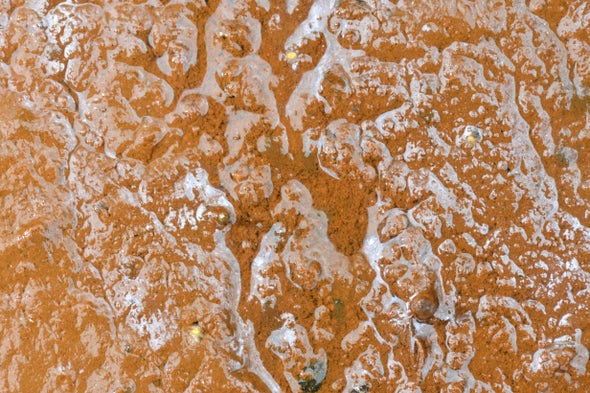(单词翻译:单击)
听力文本
This is Scientific American's 60-second Science, I'm Christopher Intagliata.
Modern painters usually get art supplies from a store—you want red paint, you buy red paint. But thousands of years ago, indigenous artists in what went on to become British Columbia actually cooked a slurry of aquatic bacteria to produce their distinctive red paints.
"Well, yeah, it was a long time ago; there were no art stores. That's what got us interested in exploring it further, because it was just such a complex series of steps to produce this paint."
Brandi MacDonald. She works in archaeological science at the University of Missouri Research Reactor, that's a nuclear reactor used for studies in a wide variety of disciplines. The paint MacDonald examined was on a fragment of ancient rock art from central British Columbia. Indigenous artists there had used a distinctive ochre pigment to paint rocks with designs of otters, fish, caribou, beavers and canoes.
Under an electron microscope, MacDonald saw tiny tubules in the paint—structures produced by a particular microbe—that tipped her off that the iron oxide pigment might be of biological origin. She later determined the pigment was produced by the aquatic bacterium Leptothrix ochracea.

"It kinda floats as this brownish auburn, orangish algal mat at the surfaces of little freshwater streams. And so it takes iron out of iron-enriched water and uses that as energy to grow these little colonies."
But the substance wasn't just straight bacterial paint. The microscopic structure looked like it was cooked, too, to make the pigment more durable and colorfast. To test that idea, MacDonald and her team gathered mats of this bacterium from a stream in Maine. They heated it under the electron microscope. And they saw that the materials in the pigment crystallized—changes they'd also seen in the original sample—which would make the paint more resistant to breaking down.
The results—and links to incredible videos of that bubbling, cooking pigment—are in the journal Scientific Reports.
MacDonald's team is now working with indigenous communities in central British Columbia to learn more about the history of rock art there and how it was produced—and to share these new microscopic insights into this ancient art.
Thanks for listening for Scientific American's 60-second Science. I'm Christopher Intagliata.
参考译文
这里是科学美国人——60秒科学系列,我是克里斯托弗·因塔格里塔。
当代画家通常在商店就能买到美术用品,你想要红色颜料,那就买红色颜料。但数千年前,在现今不列填哥伦比亚的土著艺术家,实际上通过熬煮水生菌浆液来制作其独特的红色颜料。
“没错,很久以前没有美术商店。不过,这令我们有兴趣进一步探寻,因为制作这种颜料需要一系列复杂步骤。”
布兰迪·麦克唐纳说到。她在密苏里大学研究用反应堆的考古学部门工作,研究用反应堆是用于多种学科研究的核反应堆。麦克唐纳调查的颜料来自不列颠哥伦比亚省中部的古代岩画碎片。当地艺术家用一种独特的赭色颜料在岩石上画水獭、鱼、北美驯鹿、河狸和独木舟等图案。
在电子显微镜下,麦克唐纳看到颜料中有细管,这是一种特殊细菌产生的结构,这让她知道这种氧化铁颜料可能有生物来源。她后来确定,这种颜料由水生菌赭色纤毛菌制造。
“它有点像褐色的赤褐色、橙色的海藻垫,漂浮在淡水小溪水面。因此,它从富含铁的水中提取铁,并将其用作能量来培育这些小菌落。”
但这种物质不仅仅是纯细菌涂料。它的显微结构看起来也像煮过,使色素更持久且不褪色。为了验证这个想法,麦克唐纳及其团队从缅因州的一条小溪中收集了这种细菌的菌垫。然后将其置于电子显微镜下加热。他们发现颜料中的物质结晶了,这是他们在原始样品中看到的变化,这将使颜料更不易分解。
研究结果以及这种冒泡、熬煮颜料的令人难以置信的视频链接刊登在《科学报告》期刊上。
麦克唐纳的团队现在正与不列颠哥伦比亚省中部的土著社区合作,以更多地了解该地岩石艺术的历史及其产生方式,并分享有关这一古老艺术的新的微观见解。
谢谢大家收听科学美国人——60秒科学。我是克里斯托弗·因塔利亚塔。
译文为可可英语翻译,未经授权请勿转载!
重点讲解
重点讲解:
1. a series of 一连串;一系列;连续;接连;
A series of technical foul-ups delayed the launch of the new product.
一系列技术问题延误了新产品的上市。
2. a variety of 各式各样;多种多样;
West Hampstead has a variety of good shops and supermarkets.
西汉普斯特德有各种各样不错的店铺和超级市场。
3. tip off 给…通风报信;暗中告知;
Greg tipped police off on his car phone about a suspect drunk driver.
格雷格用他的汽车电话向警方报告了一个有酒后驾驶嫌疑的司机。
4. break down (使)(物质)分解;
The oil is attacked by naturally occurring microbes which break it down.
原油受到了自然产生的分解油类物质的微生物的侵蚀。


